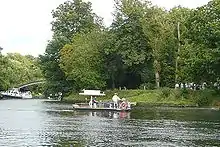Shepperton to Weybridge Ferry
The Shepperton to Weybridge Ferry is a pedestrian and cycle ferry service across the River Thames. The service has operated almost continuously for over 500 years.


Connected communities and landmarks
The ferry connects points remaining outside London in the post-1965 definition of Surrey, England. The ferry runs from Ferry Lane, in Shepperton, to a point a short tarmac-paved and tree-lined walk from Thames Street, in Weybridge. It is a few metres below Shepperton Lock on the north bank and an increased number of islands on the south bank through the construction of the approximately full-flow-sized flood relief channel which cut through Hamhaugh Island in the mid-20th century. The southern islands can include two along the River Wey which has a canal paths from this point leading to Woking and Basingstoke or to Guildford, which are national trails.[1][2]
The ferry provides a crossing for the Thames Path, and is the only ferry on route of the path itself. Three public houses are within 300 metres of the ferry, two on the south bank and two of which focus on their restaurants, one of which is a listed building and was the home of the Dutch Ambassador.[3]
Operation
The ferry operates from 0800 on weekdays, 0900 on Saturdays, and 1000 on Sundays. Service finishes at 1700 in winter and 1800 in summer. Operation is on request and intending passengers should ring the bell provided on each side of the river. When the ferry is not in service, the nearest alternative is to cross the river downstream at Walton Bridge, a round-trip distance of some 3 miles (4.8 km) on foot, further by car.[1][2]
The ferry has operated on different vessels for over 500 years discounting a 26-year-break before 1986. Exceptional expense and a very low housing density in the immediate area prohibited a proposed replacement by a long, unsupported by piers, footbridge. The river was made fully lock-controlled along these reaches. Before 1815 Shepperton at its Lower Halliford neighbourhood was one of the first fording places of the Thames.[4]
In film, fiction and the media
In fiction, the Shepperton to Weybridge Ferry is the scene of the first confrontation between the British military, six twelve-pound artillery pieces, and the Martians, five fighting-machines, that the protagonist witnesses in H. G. Wells' science fiction novel The War of the Worlds. A Martian is destroyed by a direct hit from an artillery shell, and its comrades use their heat rays to wreak vengeance on the fleeing crowds waiting to cross the ferry.[5]
See also
References
- "Shepperton and Weybridge - River Thames Passenger Ferry" (PDF). Surrey County Council. Retrieved 23 February 2009.
- "Google Maps - Shepperton to Weybridge". Google, Inc. Retrieved 23 February 2009.
- Good Pub Guide Accessed 2015-04-07
- Shepperton Conservation Area Preservation and Enhancement Proposals at 2.1, R. Fairgrieve, 1994, Borough of Spelthorne
- Wells, H.G. "Chapter 12 - What I saw of the destruction of Weybridge and Shepperton". War of the Worlds.
| Next crossing upstream | River Thames | Next crossing downstream |
| Chertsey Bridge (road) | Shepperton to Weybridge Ferry | Walton Bridge (road) |
| Next crossing upstream | Thames Path | Next crossing downstream |
| northern bank Staines Bridge |
Shepperton to Weybridge Ferry (alternative Walton Bridge) |
southern bank Hampton Court Bridge |